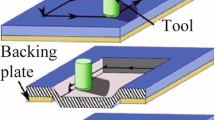Abstract
Asymmetric Incremental Sheet Forming (AISF) has been developed as a flexible process for low-volume production of sheet metal parts. In AISF, a part is obtained as the sum of localized plastic deformations produced by a simple forming tool that moves under CNC control. In spite of about 20 years of research and development, AISF has not had much industrial take-up yet. The main reason for this is that attempts to improve, among other limitations, the accuracy, speed and range of feasible geometries of the process by adapted process strategies has not brought about general solutions. This paper presents an overview of the current state of development of hybrid asymmetric incremental sheet forming processes at RWTH Aachen University. The goal of the development of hybrid ISF processes is to allow for a quantum leap of the capabilities of AISF in order to enable a broader industrial use of AISF. Two hybrid process variations of AISF are presented: stretch forming combined with ISF and laser-assisted AISF. It is shown that the combination of stretch forming and AISF can improve the time per part, sheet thickness distribution and accuracy of the final part. Laser-assisted AISF is shown to enable the flexible forming of non cold-workable materials such as magnesium and titanium alloys when the forming conditions are adapted to the temperature and strain rate dependent formability of the sheet metal. In addition, first results of the forming of hybrid aluminum-steel sheet metal are shown.























Similar content being viewed by others
References
Jeswiet J, Micari F, Hirt G et al (2005) Asymmetric single point incremental forming of sheet metal. Ann CIRP 54(2):623–649
Hirt G, Junk S, Witulski N (2001) Surface quality, geometric precision and sheet thinning in incremental sheet forming. Materials Week. München
Kitazawa K, Nakajima A (1999) Cylindrical incremental drawing of sheet metals by CNC incremental forming process. In: 6th international conference on advanced technologies of plasticity. Nürnberg, pp 1495–1500
Hirt G, Ames J, Bambach M, Kopp R (2004) Forming strategies and process modelling for CNC incremental sheet forming. Ann CIRP 52(1):203–206
Hirt G, Ames J, Bambach M (2005) A new forming strategy to realise parts designed for deep drawing by incremental CNC sheet forming, Steel Research, vol. 71/2, pp 60–166
Junk S (2003) Inkrementelle Blechumformung mit CNC Werkzeugmaschinen: Verfahrensgrenzen und Umformstrategien. Schriftenreihe Produktionstechnik, Band 25, Univesität Saarbrücken, Saarbrücken
Bambach M, Taleb Araghi B, Hirt G (2009) Strategies to improve geometric accuracy in asymmetric siungle point incremental forming. Prod Eng Res Dev 3:145–156
Bambach M (2008) Process strategies and modelling approaches for asymmetric incremental sheet forming, Umformtechnische Schriften Band 139, Shaker, Aachen
Kwiatkowski L, Urban M, Sebastiani G, Tekkaya AE (2010) Tooling concepts to speed up incremental sheet forming. Prod Eng Res Dev 4:57–64
Hadoush A, van den Boogaard T (2008) Time reduction in implicit single point incremental forming simulation by domain decomposition. In: Proceedings of the 7th International conference and workshop on numerical simulation of 3D sheet metal forming processes. Interlaken, pp 411–414
Taleb Araghi B, Manco GL, Bambach M, Hirt G (2009) Investigation into a new hybrid forming process: incremental sheet forming combined with stretch forming. Ann CIRP 58(1):225–228
Iseki H (2000) As experimental and theoretical study on a forming limit curve in incremental forming of sheet metal using spherical roller. In: Proceedings of metal forming 2000, pp 557–562
Taleb Araghi B, Goettmann A, Bambach M, Biermann T, Hirt G, Weisheit A (2010) Development of hybrid incremental sheet forming processes. In: Proceeding of metal forming conference 2010, Toyohashi
Duflou JR, Callebaut B, Verbert J, De Baerdemaeker H (2007) Laser assisted incremental forming: formability and accuracy improvement. CIRP 56(1):273–276
Göttmann A, Diettrich J, Bergweiler G, Bambach M, Hirt G, Loosen P, Poprawe R (2010) Laser-assisted asymteric incremental sheet forming (laisf) of titanium sheet metal parts. Submitted in production engineering research and development
Gottstein G (2004) Physical foundations of materials science. Springer, Berlin
Al-Samman T (2008) Magnesium–the role of crystallographic texture deformation conditions and alloying elements on formability. Cuvillier Verlag, Göttingen
Ion SE, Humphreys FJ, White SH (1982) Dynamic recrystallisation and the development of microstructure during the high temperature deformation of magnesium. Acta Metall 30(10):1909–1919
Reisgen U, Stein L, Steiners (2010) Arc joining of steel-aluminum-tailored-hybrid- blanks. In: Proceeding of the second south-east Asia international welding congress (IIW): technology—education—quality management, pp 66–82
Acknowledgments
The authors would like to thank the German Research Foundation (DFG) for the support of the depicted research within the Cluster of Excellence “Integrative Production Technology for High Wage Countries”.
Author information
Authors and Affiliations
Corresponding author
Rights and permissions
About this article
Cite this article
Taleb Araghi, B., Göttmann, A., Bambach, M. et al. Review on the development of a hybrid incremental sheet forming system for small batch sizes and individualized production. Prod. Eng. Res. Devel. 5, 393–404 (2011). https://doi.org/10.1007/s11740-011-0325-y
Received:
Accepted:
Published:
Issue Date:
DOI: https://doi.org/10.1007/s11740-011-0325-y




